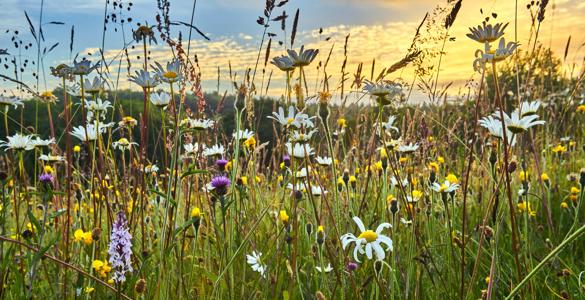Note that this article concerns the COP16 biodiversity conference. The COP29 climate change conference is the subject of a separate Senedd Research article.
In October 2024, representatives from national governments, NGOs, academia, and the private sector converged on Cali, Colombia for COP16, the world’s largest biodiversity conference. Two years on from the landmark agreements of COP15, this article discusses progress towards COP15 commitments, the outcomes of COP16, and what this all means for Wales.
Agreements from COP15
At COP15 in 2022, global governments agreed a suite of 23 targets and 4 goals collectively termed the Kunming-Montreal Global Biodiversity Framework (GBF). The GBF’s vision is for a world “living in harmony with nature” by 2050, and its mission is to “halt and reverse biodiversity loss” by 2030. A high profile element of the GBF is the ’30 by 30’ target – to protect at least 30% of land, inland waterways, and seas by 2030.
Signatories to the GBF pledged to develop and implement domestic strategies and action plans to meet their obligations. Whilst the UK Government is a signatory to the GBF, biodiversity issues are devolved and the Welsh Government has committed to implementing the GBF.
The Convention on Biological Diversity (CBD) requires Parties to submit reports on delivery against the GBF commitments. All four UK governments collectively contribute to the UK’s GBF submissions, which are coordinated by the Joint Nature Conservation Committee (JNCC). The UK report is expected to be submitted in February 2026.
Progress and frustration at COP16
More recently, COP16 aimed to take stock of progress towards the GBF commitments and develop biodiversity protections further. The main outcomes were:
- an agreement to preserve and maintain the practices of Indigenous and local communities in relation to biodiversity, and the creation of a body for Indigenous Peoples; and
- creation of the ‘Cali Fund’, which will take a portion of company profits from the use of digital sequence information – genetic data collected from plants and animals that are used to develop products – and redistribute them to Indigenous People and local communities.
Additionally, COP16 adopted a text acknowledging the interconnected nature of climate change and global biodiversity decline, and encouraged greater collaboration in tackling both. COP29 – the equivalent international conference for climate change – began less than two weeks after the conclusion of COP16.
No agreement was reached on how to finance the GBF’s biodiversity commitments, or on how to monitor whether countries were complying with international biodiversity commitments.
Wales’s progress to meeting the global commitments
The 2023 State of Nature Report, which is produced by a coalition of environmental groups, academic institutions, and statutory nature conservation bodies, describes Wales as “one of the most nature depleted countries on Earth”, with the population of monitored species having declined by 20% on average since 1994. In 2021, the Senedd declared a nature emergency.
Wales’s approach to addressing international biodiversity commitments is set out in the Welsh Government’s Nature Recovery Action Plan (NRAP). However this was published in 2015, before the GBF was agreed, and so addresses the previous CBD’s Strategic Plan for Biodiversity 2011 – 2020 (the precursor to the COP15 agreement). The Welsh Government did not update the NRAP prior to COP16, despite saying it would do so. The UK was one of more than 85% of GBF signatories that broke a pledge to submit updated biodiversity plans before the conference and instead submitted less detailed national targets.
The Welsh Government intends to introduce domestic biodiversity targets and a new biodiversity framework to help implement the GBF through an Environmental Governance, Principles, and Biodiversity Bill, which is due to be introduced to the Senedd in June 2025. The White Paper for the Bill included an overarching target that would align with the GBF:
to reverse the decline in biodiversity with an improvement in the status of species and ecosystems by 2030 and their clear recovery by 2050.However, the Welsh Government has more recently suggested a ‘purpose or mission statement’ instead of the overarching target, prompting environmental groups to say this could undermine the pace of delivery.
Detailed biodiversity targets would follow in regulations. However it may take 36 months for these regulations to be introduced after the Bill is passed, leaving a narrow window for the 2030 targets to be reached.
The Welsh Government commissioned a ‘biodiversity deep dive’ in 2022 undertaken by environmental experts and practitioners. It made eight recommendations on how to deliver the ’30 by 30’ goal in Wales.
The JNCC estimates that, as of March 2023, 10.5% of Wales’s land area has a designation explicitly related to nature conservation; and 50.3% of its marine area has some form of protected status. The terrestrial figure excludes designated landscapes (National Parks and National Landscapes), which comprise an additional 18.9% of total land area. A Welsh Government official recently told the Senedd Climate Change, Environment and Infrastructure (CCEI) Committee that a “designated landscapes expert group” was helping to determine “which areas within designated landscapes could count towards the 30x30 [goal]”. They emphasised that some areas within designated landscapes, such as town and villages, would not count towards the target.
Stakeholders have emphasised the need to both designate sufficient areas, and also ensure that designated land is managed in a way that meaningfully supports biodiversity.
Natural Resources Wales (NRW) carried out a Baseline Evaluation in 2020 to assess the condition of terrestrial and freshwater protected sites. It found that 20% of features (which can be geological or biological) within these sites were in a favourable condition, 31% were unfavourable, and 49% of sites had too little data to assess.
Protected sites in the sea are collectively called Marine Protected Areas (MPAs). A 2018 NRW survey of marine Special Areas of Conservation found that 46% of features were in a favourable condition, 45% were unfavourable, and 9% were unknown.
Some environmental NGOs have expressed concern about the quality of MPAs. Wildlife Trusts Wales says “only 3% of [MPAs] have all their features in favourable management” and that most MPAs “remain in unfavourable or unknown condition”.
The Senedd CCEI Committee has been exploring Wales’s progress towards the GBF in an inquiry framed around ‘halting and reversing the loss of nature by 2030’. Its report will be coming soon.
For more on biodiversity policy, read our Research Briefing.
Article by Matthew Sutton, Senedd Research, Welsh Parliament






